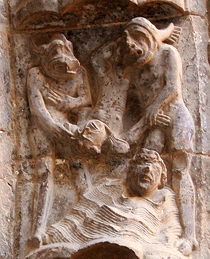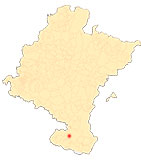Front page of the Judgment of Tudela Cathedral
Punishments of greed: in the cauldron and in the river
Along with lust, it is the sin most present in the Tudela inferno, as was common in Christian art from the Romanesque period onwards. Traditionally, the miser is depicted with a bag hanging from his neck, for example in Tudela we see a character walking towards hell with it, and another who is already burning in a cauldron. Furthermore, in another dovela we see a miser also with a bag around his neck who is thrown into a river where another character drowns, topic that in the Visio Sancti Pauli, the source that most influenced the medieval idea of hell, was the punishment reserved for usurers.
The special emphasis placed on denouncing the sin of greed and usury, and its relation to the activities of money changers, may have to do with a specific problem of the Church and the city of Tudela at that time. The collegiate church had several disputes with Jews in the city, as they refused to pay tithes and first fruits. Perhaps the particular presence of these themes was a way of denouncing, on the part of the mentors of the programme, these Jews of Tudela, whose main activity was that of moneylenders and money changers, who enjoyed the protection of King Sancho el Fuerte, which provoked a revolt in 1234, a date close to proposal for the creation of the façade.
ARAGONÉS ESTELLA, E., "El mal imaginado por el gótico", Príncipe de Viana, nº63, (2002), pp. 7-81.
GARCÍA GAÍNZA, C. et alii, Catalog Monumental de Navarra, I, Merindad de Tudela, Pamplona, Institución Príncipe de Viana, 1980.
LANCE, J., "Le portail du Jugement de Santa María La Mayor de Tudela", Cahiers de Civilisation Médiévale, 45, 2002, pp.255-274.
MARIÑO LÓPEZ, B., "Iudas mercator pessimus. Mercaderes y peregrinos en la imaginería medieval", conference proceedings del VI congress Español de Historia del Arte: los caminos y el arte, vol. II, Santiago de Compostela, 1989, pp. 31-43.
MARIÑO LÓPEZ, B., "Sicut in terra et in inferno: la portada del Juicio en Santa María de Tudela", file español de Arte, nº67, (1989), pp. 157-168.
MELERO MONEO, M.L., "Aproximación a la iconografía del 4º Jinete del Apocalipsis", Lambard, nº2 (1981-1983), Barcelona 1986, pp.125-128.
MELERO MONEO M.L., Escultura románica y del primer gótico de Tudela, Centro Cultural Castel Ruiz, Tudela, 1997.
MELERO MONEO, M.L., "Los textos musulmanes y la Puerta del Juicio de Tudela", conference proceedings del V congress español de historia del Arte, (Barcelona 1984), vol. I, Barcelona, 1986, pp. 203-217.
MELERO MONEO, M.L., "Recherches sur l'iconographie des métiers à Tudela", Cahiers de Civilisation Médiévale, nº 30, (1987), pp. 71-76.













